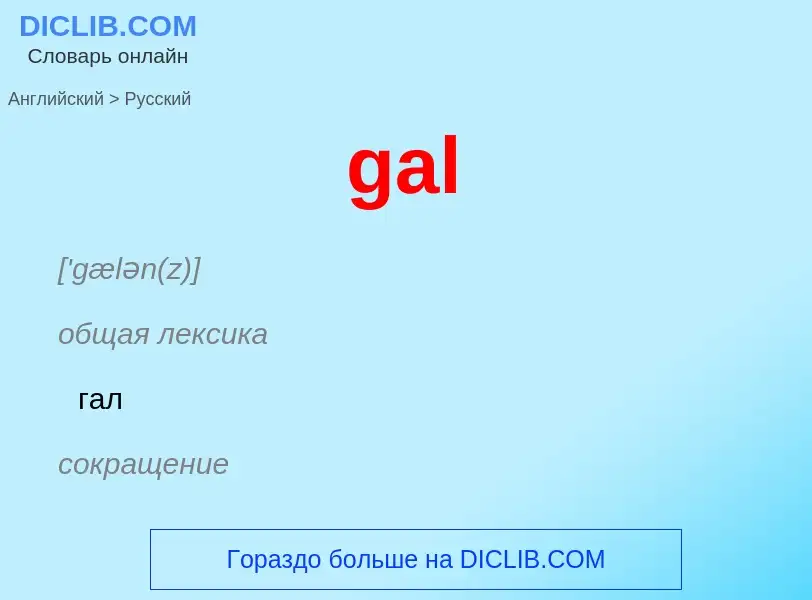Перевод и анализ слов искусственным интеллектом ChatGPT
На этой странице Вы можете получить подробный анализ слова или словосочетания, произведенный с помощью лучшей на сегодняшний день технологии искусственного интеллекта:
- как употребляется слово
- частота употребления
- используется оно чаще в устной или письменной речи
- варианты перевода слова
- примеры употребления (несколько фраз с переводом)
- этимология
gal - перевод на русский
['gælən(z)]
общая лексика
гал
сокращение
от gallon
существительное
[gæl]
общая лексика
гал (единица ускорения)
молодая женщина
сокращение
от gallons
разговорное выражение
девушка
девчонка
собирательное выражение
девчонка, девушка
общая лексика
Generic Array Logic
общий логический массив, GAL-логика
разработанная фирмой Lattice Semiconductor разновидность PAL, базирующаяся на ячейках EEPROM-памяти. Может быть стёрта и перепрограммирована
Смотрите также
Определение
Википедия

The Gal Vihara (Sinhala: ගල් විහාර, lit. 'rock monastery'), and known originally as the Uttararama (Sinhala: උත්තරාම, lit. 'the northern monastery'), is a rock temple of the Buddha situated in the ancient city Polonnaruwa, the capital of the ancient Kingdom of Polonnaruwa, now present-day Polonnaruwa, in North Central Province, Sri Lanka. It was fashioned in the 12th century by King Parakramabahu I. The central feature of the temple is four rock relief statues of the Buddha, which have been carved into the face of a large granite gneiss rock. The images consist of a large seated figure, another smaller seated figure inside an artificial cavern, a standing figure, and a reclining figure. These are considered to be some of the best examples of ancient Sinhalese sculpting and carving arts, and have made the Gal Vihara the most visited monument at Polonnaruwa.
The images of Uttararama follow a different style from the images of the previous Anuradhapura period, and show some significant differences. The identity of the standing image is subject to a certain amount of dispute among historians and archaeologists, some of whom argue that it depicts the monk Ananda rather than the Buddha. Each of the images have been carved in a way that uses a maximum possible area of the rock, and their heights seem to have been decided based on the height of the rock itself. Each statue appears to have had its own image house, as indicated by the remains of brick walls at the site. The Uttararama was where Parakramabahu I held a congregation of monks to purify the Buddhist priesthood, and later drew up a code of conduct for them. This code of conduct has been recorded in an inscription on the same rock face containing the images of the Buddha.


.jpg?width=200)


